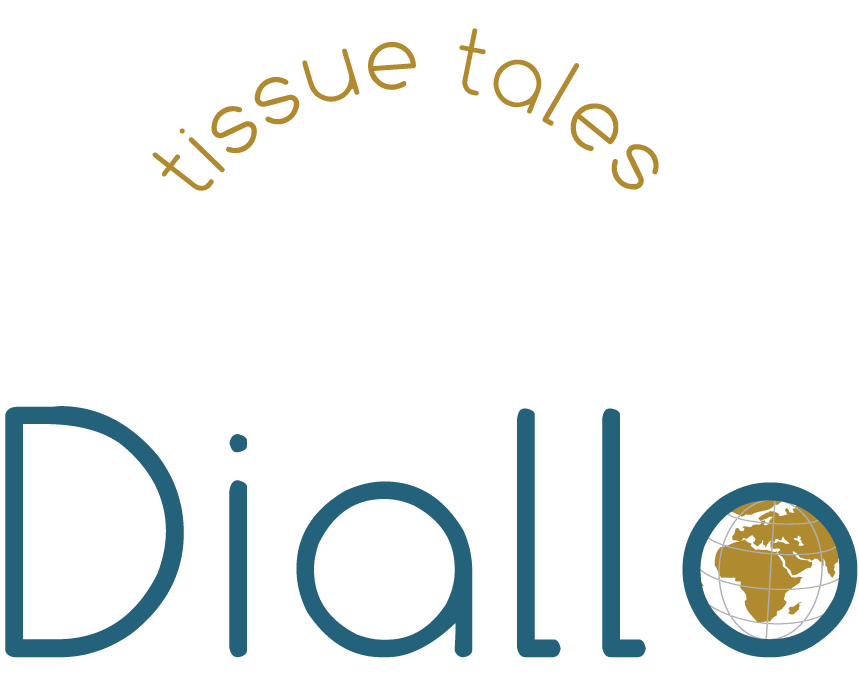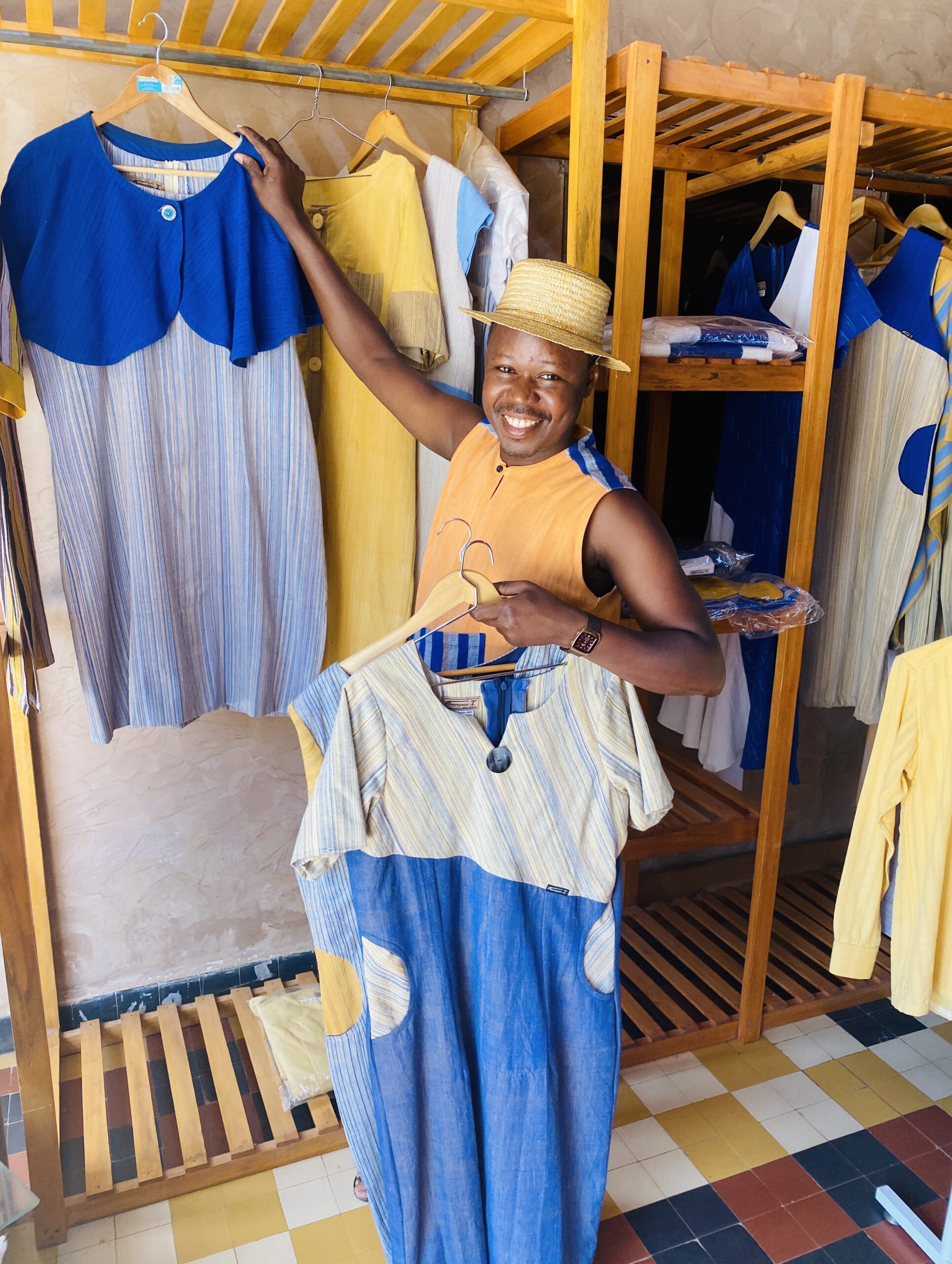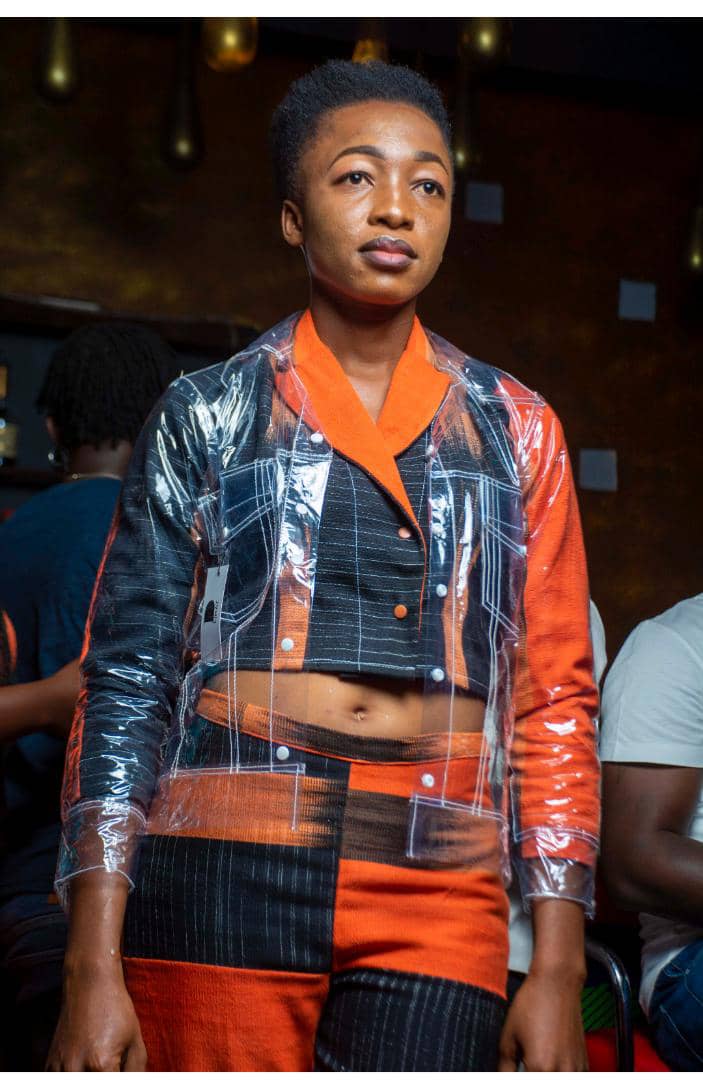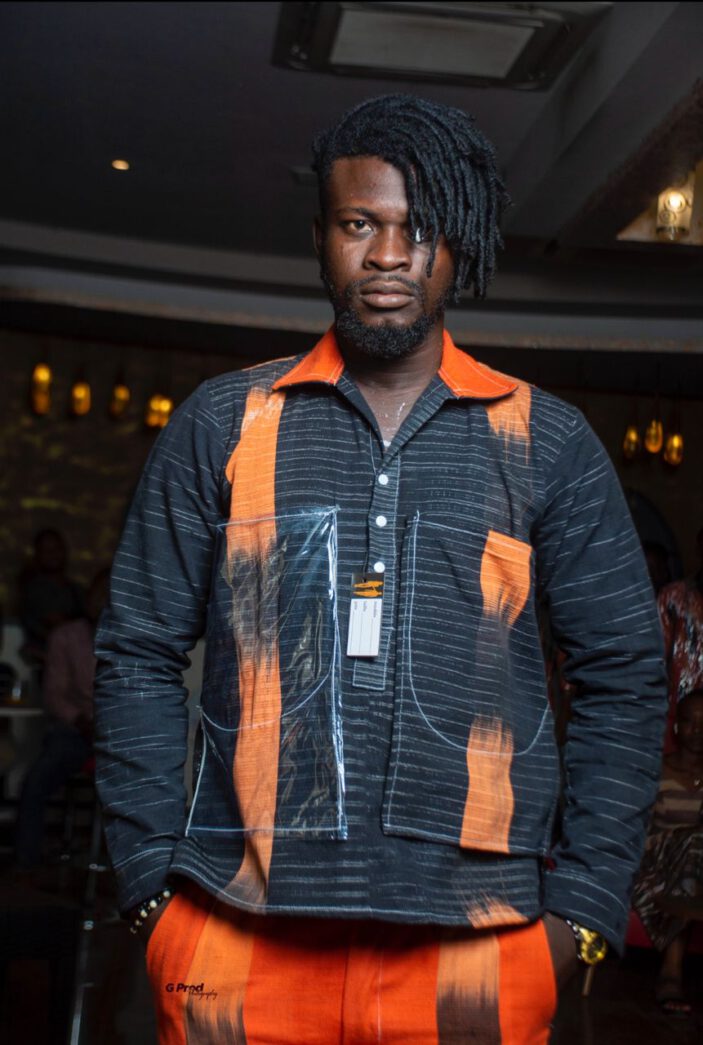—-Scroll down to read the French and German Version—-
The fashion world in Ouagadougou welcomes me in its very own way and opens its doors to me as soon as I arrive. After meeting my landlady’s niece, Hortense, she tells me that she is a model. Unbelievable! On Saturday, there is a fashion show in a lounge on the sixth floor of a high-rise building in the city centre, admission is free, and I am happy to be there. Now there is only one challenge for me: how to find my way there. After all, Ouagadougou is a big city of three million people, where street names are not necessarily useful for orientation. Google Maps can help if I get my private digital infrastructure up and running: an internet flat rate for the Burkinabe SIM card is available at the kiosk to which Amatou accompanies me. She is 17 and the girl for everything in my new home. She cleans, cooks, washes and shows me hidden market stalls and shops. I could never find them on my own in the confusion of the mountain and valley roads made of red sand that were almost impassable due to the last rainy season. The kiosk owner sends me units on my phone for the equivalent of 7 euros and an internet flat rate for 6 euros. A bottle of oil still crosses the counter while I am already thinking about how I will get around the Burkinabe capital in the coming days until the fashion show.
Traffic for good nerves
Through an acquaintance of Hortense’s, I book a Toyota for three days and plunge into an adventure of unknown dimensions – driving in a traffic chaos that is almost apocalyptic for my order-loving German mind. When I take my first seat in my mobility dream, I manage the first few kilometres by incessantly talking myself into it and paying extremely close attention to the masses of mopeds, scooters and bicycles that crowd dangerously close to my vehicle from all sides. It takes me a while to understand where my place is on the road. Somewhere in the middle of the lane seems quite alright. I don’t know if it’s my driving or the colour of my skin, I get stopped by the police every time on my first two trips. Once I am asked to show a tax form, once a traffic policeman gives me a hefty ticket because I am desperately trying to get directions home from my mobile phone at a traffic light.
Contemporary ethic fashion made of organic cotton
On the day of the first fashion event, I am allowed to witness in Burkina, I visit the capital city atelier of Francois 1er in the afternoon, a fashion brand that has been successfully established for several years. The founder, Francois 1er, started sewing in the Ivory Coast. He was trained in Dakar, the capital of Senegal, and has been successful in the fashion capital Paris for more than 40 years. Francois 1er processes organic cotton from Burkina into particularly fine Faso dan Fani in its own weaving mill in Koudougou. The yarn is dyed exclusively on a vegetable basis.
Laurent Yaméogo, the brand’s Artistic Director, is responsible for creation, cutting and production in Ouagadougou. This friendly stylist is called Laurent le Saint by everyone. A friend gave him this nickname and Laurent only accepted it under protest: “After all, you don’t call yourself a saint,” he says with a smile. He gives me a detailed tour of the studio, the production, the shop and shows me his creations for fashion shows. His specialities are shirts, tunics and trouser suits with interesting pocket solutions and applications for men. I am completely infatuated with the unusually high-quality and light fabrics. Unfortunately, these are not for sale and understandably intended for the brand’s own production. So, I treat myself to one of the creations, a sheath dress made of Faso dan Fani with lime green bellows pockets, matching cap sleeves and front zipper.
Contrasting styles and environments
In the evening, I venture to the fashion show. I find the building in the street with the beautiful name “Avenue du Président Thomas Sankara” almost at once. In the dark, I look for the entrance, walk once around the building and don’t notice the security grids. After all, the last coup happened only three weeks ago and the area around the French Embassy is still widely cordoned off. Two soldiers stop me and want to know if I haven’t seen the barrier. Helplessly, I ask where the nightclub is, which they don’t know. Full of unease, I turn around and a security guard from the nightclub welcomes me at the front of the building and sends me into the lift and up to the sixth floor. There, the contrast with my brief interlude with the military could not be greater: I am standing in a lounge with an open-air area, Hortense is already coming to meet me, models are being made up and Mireille Darbre, the fashion designer of the DLIMAT label, takes me to my place in the indoor area. Over the next two hours, the room slowly fills with people of all ages and skin colours. A young body paint artist kicks things off by decorating the models’ bodies with white ornaments and patterns. When the main act finally starts, I am overwhelmed by the beautiful models and the collection, which boldly mixes plastic and Faso dan Fani and combines it with many three-dimensional bag elements. Elegance, colourfulness and rough workwear combine to create aesthetically pleasing individual pieces.
The professional ambience of the event with a view of the skyline, the mood, the creativity and the openness of the community pleasantly surprised me, also and especially because we are all in a country that has to wage war in many regions and where more than two million people are on the run – a discrepancy that is hard to comprehend and bear.
Scroll down for french and german version
Made in Burkina
Le monde de la mode à Ouagadougou m’accueille à sa manière et m’ouvre sa porte à peine arrivée. Après avoir fait la connaissance de la nièce de ma logeuse, Hortense, elle m’annonce qu’elle est mannequin. C’est incroyable! Samedi, un défilé de mode aura lieu dans un salon au sixième étage d’un immeuble du centre-ville, l’entrée est gratuite et je suis ravie d’y assister. Maintenant, il n’y a qu’un seul défi pour moi: comment trouver mon chemin. Après tout, Ouagadougou est une métropole de trois millions d’habitants, dans laquelle les noms de rue ne servent pas forcément à s’orienter. Google Maps peut m’aider si je fais fonctionner mon infrastructure digitale privée: un forfait Internet pour la carte SIM burkinabè est disponible au kiosque où Amatou m’accompagne. Elle a 17 ans et est la bonne à tout faire dans ma nouvelle maison. Elle fait le ménage, la cuisine, la lessive et me montre des étals de marché et des magasins cachés. Dans le chaos des pistes avec des énormes bosses et trous en sable rouge, presque impraticables à cause de la dernière saison des pluies, je ne pourrais jamais les trouver seule. Le propriétaire du kiosque m’envoie des unités sur mon téléphone pour l’équivalent de 7 euros et un forfait Internet pour 6 euros. Une bouteille d’huile passe encore sur le comptoir, tandis que je continue déjà à réfléchir à la manière dont je vais me déplacer dans la capitale burkinabè dans les jours à venir, jusqu’au défilé de mode.
Trafic pour les bons nerfs
Par l’intermédiaire d’une connaissance d’Hortense, je réserve une Toyota pour trois jours et me lance dans une aventure d’une ampleur inconnue – conduire dans un chaos routier presque apocalyptique pour mon esprit allemand amoureux de l’ordre. Lorsque je m’installe pour la première fois dans mon rêve de mobilité, je parviens à parcourir les premiers kilomètres en me rassurant sans cesse et en restant extrêmement concentré sur les masses de mobylettes, de scooters et de vélos qui se pressent dangereusement de tous côtés contre mon véhicule. Il me faut un certain temps pour comprendre où se trouve ma place sur la route. Quelque part au milieu de la chaussée, tout semble en ordre. Je ne sais pas si c’est ma façon de conduire ou la couleur de ma peau, je me fais arrêter à chaque fois par la police lors de mes deux premières sorties. Une fois, on me demande de présenter un formulaire d’impôt, une autre fois, un agent de la circulation me donne une amende salée parce que j’essaie désespérément d’arracher à mon téléphone portable le chemin du retour à un feu rouge.
Mode ethique contemporain en coton bio
Le jour du premier événement mode auquel j’ai la chance d’assister au Burkina, je visite l’après-midi l’atelier de la capitale de François 1er, une marque de mode établie avec succès depuis plusieurs années. Le fondateur, François 1er, a commencé la couture en Côte d’Ivoire. Il a été formé à Dakar, la capitale du Sénégal, et a réussi depuis plus de 40 ans dans la capitale de la mode, Paris. François 1er transforme le coton bio du Burkina en Faso dan Fani particulièrement fin dans son propre atelier de tissage à Koudougou. Le fil est teinté exclusivement à base de plantes.
Laurent Yaméogo, Directeur Artistique de la marque est responsable de la création, de la coupe et de la production à Ouagadougou. Ce sympathique styliste est appelé par tous Laurent le Saint. C’est un ami qui lui a donné ce surnom et Laurent ne l’a accepté qu’en protestant : “Après tout, on ne se proclame pas Saint”, souligne-t-il en souriant. Il me fait une visite détaillée de l’atelier, de la production, du magasin et me montre ses créations pour le prochain défilé de mode. Sa spécialité : les chemises, les tuniques et les tailleurs-pantalons avec des solutions de poches et des applications intéressantes pour hommes. J’ai un véritable coup de cœur pour ces tissus inhabituellement légers et de grande qualité. Ceux-ci ne sont malheureusement pas disponibles à la vente et sont, de manière compréhensible, destinés à la production propre de la marque. Je m’offre donc une des créations, une robe fourreau en Faso dan Fani avec des poches à soufflet vert citron, des manches papillon assorties et une fermeture éclair sur le devant.
Des contrastes de styles et d’environnements
Le soir, j’ose me rendre au défilé de mode. Je trouve presque du premier coup le bâtiment dans la rue qui porte le joli nom d'”Avenue du Président Thomas Sankara”. Dans l’obscurité, je cherche l’entrée, fais une fois le tour du bâtiment et ne remarque pas la barrière de sécurité. Après tout, le dernier coup d’État ne remonte qu’à trois semaines et le périmètre de l’ambassade de France est toujours largement bouclé. Deux soldats m’arrêtent et me demandent si je n’ai pas vu les barrières de sécurité. Impuissant, je leur demande où se trouve la discothèque, qu’ils ne connaissent pas. Plein de malaise, je fais demi-tour et un agent de sécurité de la discothèque m’accueille à l’avant du bâtiment et m’envoie dans l’ascenseur et au sixième étage. Là, le contraste avec mon bref intermède avec les militaires ne pourrait pas être plus grand : Je me trouve dans un salon en plein air, Hortense vient déjà à ma rencontre, des mannequins sont maquillés et Mireille Darbre, la créatrice de mode du label DLIMAT, m’amène à ma place dans l’espace intérieur. Pendant les deux heures qui suivent, l’espace se remplit lentement de personnes de tous âges et de toutes couleurs de peau. Le coup d’envoi est donné par une jeune artiste de bodypainting qui décore les corps des mannequins d’ornements et de motifs blancs. Lorsque l’acte principal commence enfin, je suis subjuguée par les magnifiques mannequins et la collection qui mélange courageusement le plastique et le Faso dan Fani et les combine avec de nombreux éléments de sacs tridimensionnels. L’élégance, la richesse des couleurs et la rudesse du workwear s’unissent pour créer des pièces uniques et esthétiques.
L’ambiance professionnelle de l’événement avec vue sur la skyline, l’atmosphère, la créativité et l’ouverture de la communauté m’ont agréablement surpris, et ce aussi et surtout parce que nous nous trouvons tous dans un pays qui doit faire la guerre dans de nombreuses régions et où plus de deux millions de personnes sont en fuite – un décalage difficile à comprendre et à supporter.
Made in Burkina
Die Modewelt in Ouagadougou heißt mich auf ihre ganz eigene Art willkommen und öffnet mir ihre Türen, kaum, dass ich angekommen bin. Nachdem ich die Nichte meiner Vermieterin, Hortense, kennen gelernt habe, eröffnet sie mir, dass sie Model ist. Unglaublich! Am Samstag findet eine Modenschau in einer Lounge im sechsten Stock eines Hochhauses im Stadtzentrum statt, der Eintritt ist frei und ich freue mich, dabei sein zu dürfen. Jetzt gibt es nur eine Herausforderung für mich: Wie finde ich meinen Weg dorthin. Immerhin ist Ouagadougou eine Dreimillionen-Metropole, in der Straßennamen nicht unbedingt der Orientierung dienen. Google Maps kann helfen, wenn ich meine private digitale Infrastruktur zum Laufen bringe: Eine Internet-Flat für die burkinische SIM-Karte gibt es am Kiosk, zu dem mich Amatou begleitet. Sie ist 17 und das Mädchen für alles in meinem neuen Zuhause. Sie putzt, kocht, wäscht und zeigt mir versteckte Marktstände und Geschäfte. Im Wirrwarr, der durch die letzte Regenzeit fast unpassierbaren Berg- und Talpisten aus rotem Sand könnte, ich diese niemals allein finden. Der Kioskinhaber schickt mir für umgerechnet 7 Euro Einheiten auf mein Telefon und eine Internet-Flat für 6 Euro. Eine Flasche Öl geht noch über den Tresen, während ich schon weiter überlege, wie ich mich in den kommenden Tagen bis zur Modenschau durch die burkinische Hauptstadt bewegen soll.
Verkehrskultur für gute Nerven
Über einen Bekannten von Hortense buche ich mir für drei Tage einen Toyota und stürze mich in ein Abenteuer unbekannten Ausmaßes – Autofahren in einem für meinen ordungsverliebten deutschen Geist fast schon apokalytischen Verkehrschaos. Als ich das erste Mal in meinem Mobilitätstraum Platz nehme, schaffe ich die ersten paar Kilometer, indem ich mir unablässig gut zurede und äußerst konzentriert auf die Massen an Mofas, Scootern und Fahrräder achte, die sich gefährlich nah von allen Seiten an mein Gefährt drängen. Es dauert eine Weile, bis ich verstehe, wo mein Platz auf der Straße ist. Irgendwo in der Mitte der Fahrbahn scheint ganz in Ordnung zu sein. Ich weiß nicht, ob es an meinem Fahrstil oder an meiner Hautfarbe liegt, ich werde bei meinen ersten beiden Ausflügen jedes Mal von der Polizei angehalten. Einmal soll ich ein Steuerformular vorweisen, einmal erteilt mir ein Verkehrspolizist einen saftigen Strafzettel, weil ich an einer Ampel meinem Handy verzweifelt den Heimweg entlocken will.
Zeitgenössische, ethische Mode aus Biobaumwolle
Am Tag des ersten Modeereignisses, das ich in Burkina miterleben darf, besuche ich am Nachmittag das Hauptstadtatelier von Francois 1er, einer seit mehreren Jahren erfolgreich etablierten Modemarke. Der Gründer, Francois 1er, hat in der Elfenbeinküste mit dem Nähen begonnen. In Dakar, der Hauptstadt des Senegal, wurde er ausgebildet und seit mehr als 40 Jahren in der Modehauptstadt Paris erfolgreich. Francois 1er verarbeitet Biobaumwolle aus Burkina in der eigenen Weberei in Koudougou zu besonders feinem Faso dan Fani. Das Garn wird ausschließlich auf pflanzlicher Basis gefärbt.
Für Kreation, Schnitt und Produktion in Ouagadougou ist Laurent Yaméogo, Directeur Artistique der Marke, zuständig. Der sympatische Designer wird von allen Laurent le Saint genannt. Den Spitznamen hat ihm ein Freund gegeben und Laurent hat ihn nur unter Protest akzeptiert: „Schließlich erklärt man sich ja nicht selber zu einem Heiligen“, betont er. Er gibt mir eine detaillierte Führung durch das Atelier, die Produktion, den Laden und zeigt mir seine Kreationen für die nächste Modenschau. Seine Spezialität sind Hemden, Tuniken und Hosenanzüge mit interessanten Taschenlösungen und Applikationen für Herren. Ich bin ganz vernarrt in die ungewöhnlich hochwertigen und leichten Stoffe. Diese sind leider nicht verkäuflich und verständlicherweise für die eigene Produktion der Marke vorgesehen. Also gönne ich mir eine der Kreationen, ein Etuikleid aus Faso dan Fani mit limonengrünen Blasebalgtaschen, passenden Flügelärmeln und Reissverschluss im Vorderteil.
Gegensätzliche Stile und Welten
Am Abend wage ich die Fahrt zur Modenschau. Ich finde das Gebäude in der Straße mit dem schönen Namen „Avenue du Président Thomas Sankara“ fast auf Anhieb. Im Dunkeln suche ich den Eingang, gehe einmal um das Gebäude und bemerke die Sicherheitsabsperrung nicht. Immerhin ist der letzte Staatstreich erst drei Wochen her und das Areal um die französische Botschaft immer noch weitläufig abgeriegelt. Zwei Soldaten halten mich auf und wollen wissen, ob ich die Absperrung nicht gesehen haben. Hilflos frage ich nach der Diskothek, die sie nicht kennen. Voller Unbehagen mache ich kehrt und ein Sicherheitsmitarbeiter der Diskothek empfängt mich auf der Vorderseite des Gebäudes und schickt mich in den Aufzug und in den sechsten Stock. Dort könnte der Kontrast zu meinem kurzen Intermezzo mit dem Militär nicht größer sein: Ich stehe in einer Lounge mit Open Air-Bereich, Hortense kommt mir schon entgegen, Modells werden geschminkt und Mireille Darbre, die Modeschöpferin des Labels DLIMAT bringt mich zu meinem Platz im Indoor-Bereich. In den kommenden zwei Stunden füllt sich der Raum langsam mit Menschen aller Altersklassen und Hautfarben. Den Auftakt gibt eine junge Bodypaint-Artistin, die die Körper der Models mit weißen Ornamenten und Mustern verziert. Als es mit dem Haupt-Act endlich losgeht, bin ich überwältigt von den wunderschönen Models und der Kollektion, die Plastik und Faso dan Fani mutig mixt und mit vielen dreidimensionalen Taschenelementen kombiniert. Eleganz, Farbenpracht und rauhe Workwear vereinen sich zu ästhetischen Einzelteilen.
Das professionelle Ambiente der Veranstaltung mit Blick auf die Skyline, die Stimmung, die Kreativität und die Offenheit der Community haben mich angenehm überrascht, und zwar auch und gerade weil wir uns alle in einem Land befinden, das in vielen Regionen Krieg führen muss und in dem mehr als zwei Millionen Menschen auf der Flucht sind – eine Diskrepanz, die nur schwer zu begreifen und zu ertragen ist.





